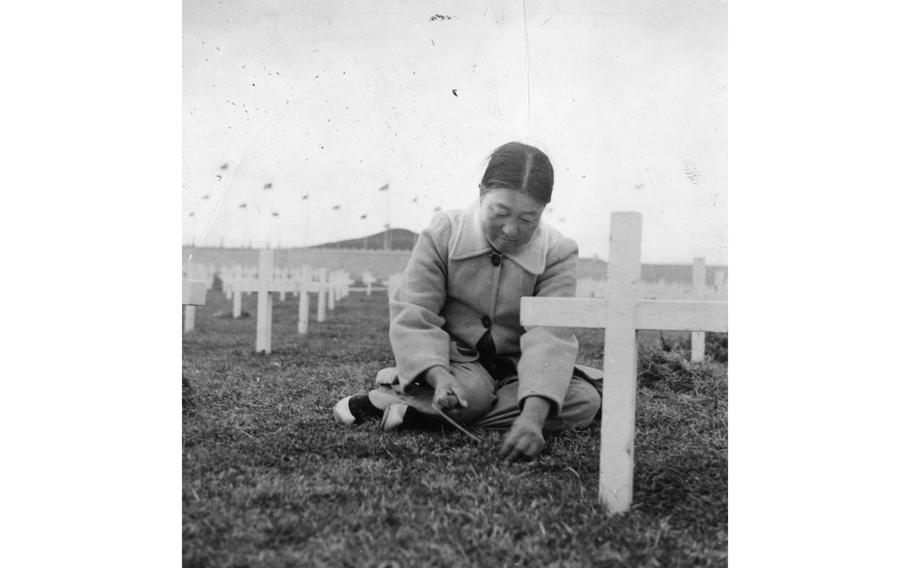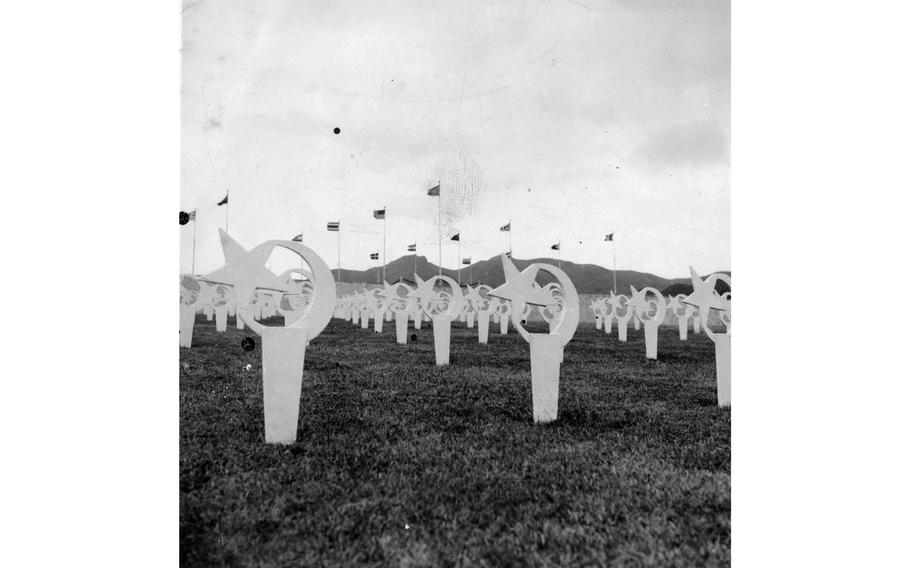
A Korean woman pulls weeds among the gravesites at the world’s only remaining United Nations cemetery in Busan, South Korea, sometime in early 1955. (Stars and Stripes)
This article first appeared in the Stars and Stripes Pacific edition, April 4, 1955. It is republished unedited in its original form.
Precisely at 8 a.m. every day a tall, lanky U.S. Army sergeant gives the word and 21 flags of the U.N. countries that fought in Korea are raised over the more than 2,000 dead who still rest in the only U.N. cemetery in the world.
Later in the day, nearly a dozen old mama-sans patiently pull weeds from the neatly clipped green grass that grows over the graves of the fallen heroes of history’s first war against communism.
Each month fewer and fewer come to view this hillside cemetery four miles from Pusan where it overlooks the Sea of Japan.
But even today — four years after the first bodies were laid to rest in January 1951 — it is more than a cemetery.
The row upon row of white grave markers — the wooden crosses, Stars of David, Turkish stars and crescents the wind-whipped flags, bronze plaques, the little quonset hut chapel stand more as a memorial to all those who died in the Korean war.
The U.S. removed its war dead in November, 1951, and since then the dead of six other nations have been returned to their native lands.
Dog tags and embossed nameplates are the only identification on the grave markers, and each lists the religion of its dead.
The cemetery is different from the elaborate memorials for the dead of other wars. It has no tombs nor monuments.
Yet it, too, bears the great scar of the places of all war dead — the unknown soldiers.
They are buried in the plots of various U.N. countries, and four — whose nationalities, too, are unknown — are buried together.
Members of the U.S. Army’s 114th Graves Registration Co. who operate the cemetery, are sure no Americans are among these unknown soldiers.
And here, too, is the loneliest grave in any cemetery in the world — a Russian bomber pilot shot down by U.S. Navy fighters over the Yellow Sea in September 1950. Lt. Mishin Gennady, USSR Air Force, serial No. 25054, lies beneath a white cross in what has been set off as the “nonbelligerent area.”
Only a few yards away — and separated by a low hedge — lie the bodies of British, French and other soldiers of the U.N. The Russian’s grave — the only one in the non-belligerent area — gets whatever attention is necessary — which is very little. No one has placed flowers there.
The 13 Yanks who operate the cemetery constantly check the condition of all graves, repair the crosses and other markers, and keep an accurate record of all interments and disinterments.
Members of a near-by Australian unit care for the graves of U.K. forces.
Although some nations take their dead home, the nearly 400 Turkish soldiers buried at the cemetery will never be moved, say the two Turks assigned to care for their plots.
To the bayonet-fighting Turks, that earth has now become sacred and to it they have added a box of earth taken from the grave of Kemal Ataturk, founder of the Republic of Turkey. The specially glass-encased box of earth is sunken into the ground at the foot of Turkey’s flag.

Star and crescent grave markers mark the final resting place of over 400 Turkish soldiers buried at the United Nations cemetery in Busan, South Korea. Although some nations take their dead home, a Stars and Stripes article in 1955 noted that the Turkish fighters will never be moved. According to two Turkish grave attendants interviewed for the article, the earth has become sacred. A box of earth taken from the grave of Kemal Ataturk, founder of the Republic of Turkey has been added to the Turkish burial site. The specially glass-encased box of earth is sunken into the ground at the foot of Turkey’s flag. (Stars and Stripes)
For the handful of Koreans of the little village of Tanggok, where the cemetery is located, this resting place for the dead has brought a new kind of life.
Nearly all of the cemetery’s 72 acres were once rice paddies from which the Koreans made their living. But today most of them are like village headmaster Choe Sae Hwan who now has an easy life as one of the 50 Korean workers at the cemetery.
He recalls that the heavy granite for the pillars at the entrance and the stone wall that surrounds part of the cemetery was shuttled by assault boats from Yong-do island and lugged by A-frames.
The cluster of green-trimmed, white quonset huts at the cemetery includes offices, the 70-seat chapel of all faiths, and a mortuary. During the height of the bitter Korean fighting the mortuary operated 24 hours a day.
The first bodies were laid to rest even as Army engineers were working around the clock to complete the cemetery, which was formally dedicated on Apr. 6, 1951.
The cemetery was not the only one for U.N. Forces. There was one in Taegu during the early days of the war, and later one at Inchon.
The 1st Cav. Div. established a cemetery while it was in Korea and there were many other temporary resting places for U.N. war dead.
Some Korean war dead may never be found, but outside of Pusan more than 2,000 rest in peace — and in Korea there’s a peace they helped make possible.